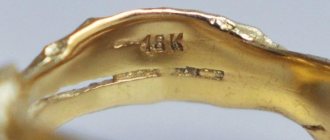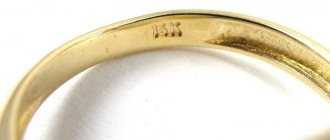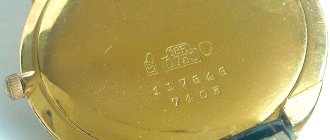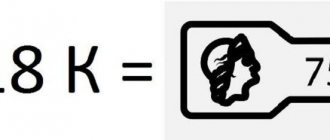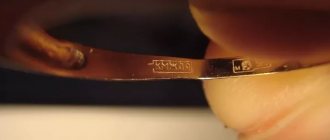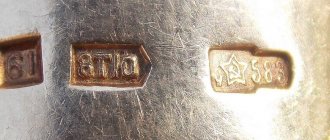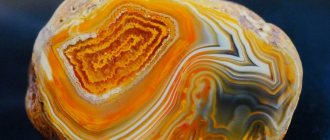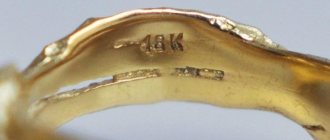Post updated: Nov 19, 2015
In any area of commerce, a standard is needed - a guideline that will be a universal way of assessing the value of a particular thing. It is a specific measure of weight or volume, as well as a standard of quality. In the jewelry industry, where metals are sold in small quantities, stones are quite microscopic, even a layer of sputtering from particles of noble metal is valued, a specific measure of weight has always been necessary. The carat has firmly entered people's lives, measuring the mass of gold in grams, or the purity and volume of precious stones. Gold is one of the most sought-after metals; it is used as an indicator of a country's wealth, regulates trading on the stock exchange, is used in industry and gives joy to jewelry owners. Specialists - gold miners, sales intermediaries, stockbrokers, jewelers and their assistants - know how to determine the volume of gold, its quality and value using this measure. Just a few tips will help you figure it out and finally figure out how many grams are in your gold product, if its fineness is indicated in gold karat, where this measurement system came from and how to apply it.
History of karat
The carat is not an element of the system of weights and measures, which is why it is called non-systemic. The name comes from the carob tree Ceratonia siliqua. This is an evergreen tree that has long been common in the Mediterranean. It produced fruits - pods that always corresponded to one another in weight and volume. Noticing this feature, people began to use its pods as a weight standard since biblical times. During the Roman Empire, the mature dry pods were introduced into the system of measurements; one unit equaled 0.19 grams and was called siliqua. Carat is only the Greek version of this name, which came into use later.
There are many varieties of karat, which are similar in essence, but have different numerical equivalents. A metric carat is 0.2 grams. In the Middle East and North Africa, the qirat was used - the so-called Arabic carat, which was measured in milligrams and had an approximate value (from 195 to 223 mg). An English carat is also an indicator in milligrams; it is equal to 205 mg. Egypt has always had its own standards for measurements. Their carat is measured in fractions of faddan and qadah, and was approximately 0.064 l or just over 175 sq. meters. These measures do not apply to precious metals and stones.
A little about this test
The state gold reserve is formed from 24 carat metal. In Rus' it was called red for its red color when heated. To obtain the purest metal, the ore is subjected to an expensive refining process.
Strength
24 carat gold has a strength of 120 MPa. It is classified as a material subject to deformation. Expensive jewelry breaks under physical stress.
The metal is soft, marks remain on the surface if you run a knife across it. Melting point – 1063 degrees Celsius. The color of the molten metal is greenish. Aurum boils at 2947 °C.
Pure 24-karat gold is malleable and ductile. One gram can be rolled into foil with an area of 1 square. m or make 2.5 m of wire.
Alloy shade chart
The color of jewelry alloys depends on the type of impurities. 24 carats is a pure metal, there are practically no additives in it. Therefore, the color remains constant - bright yellow. The table shows the color change of Au with various impurities.
| Share of gold, % | Proportion of impurities, % | Main composition of impurities | Alloy color |
| 99,9 | 0,1 | Silver, palladium, platinum, copper | Yellow |
| 96,0 | 4 | Copper | Yellow |
| Copper | Red | ||
| 75,0 | 25,0 | Copper, silver, nickel; copper, silver | Yellow |
| Nickel, zinc, copper; palladium, silver, copper | White | ||
| 50,0–58,0 | 42–50 | Copper, silver | red |
| Silver, copper | Yellow | ||
| Silver, copper | Green | ||
| Nickel, silver, zinc, copper | White | ||
| 37,5 | 62,5 | Copper, silver | Red |
| Silver, palladium, copper | Pink |
Alloy shade chart
The color of jewelry alloys depends on the type of impurities. 24 carats is a pure metal, there are practically no additives in it. Therefore, the color remains constant - bright yellow. The table shows the color change of Au with various impurities.
| Share of gold, % | Proportion of impurities, % | Main composition of impurities | Alloy color |
| 99,9 | 0,1 | Silver, palladium, platinum, copper | Yellow |
| 96,0 | 4 | Copper | Yellow |
| Copper | Red | ||
| 75,0 | 25,0 | Copper, silver, nickel; copper, silver | Yellow |
| Nickel, zinc, copper; palladium, silver, copper | White | ||
| 50,0–58,0 | 42–50 | Copper, silver | red |
| Silver, copper | Yellow | ||
| Silver, copper | Green | ||
| Nickel, silver, zinc, copper | White | ||
| 37,5 | 62,5 | Copper, silver | Red |
| Silver, palladium, copper | Pink |
Metal and alloys
A very important parameter of the metal is the purity of gold. To be sure of the quality of the metal, you should consider the special markings on the product. It is this parameter that allows you to determine the degree of purity of the alloy. One carat here is one fraction of the 24 pure substance in that particular bar, coin or other item.
There are many alloys of gold and this is rather a necessity, because gold itself is a very soft metal, it does not hold its shape and is easily deformed. Over many years of development in the jewelry field, traditional alloy options have appeared that do not cause allergies in humans, make the metal durable and hold its shape well, and give a beautiful shade. Very often, silver and copper are used for alloys. For non-ferrous metals - white, green, black, rose gold, additional tint additives are also used. To understand how valuable an item made of a precious metal is, you need to know not only its weight and type of gold, but also its fineness, which can be measured in numerical value or carats. The numerical value can more accurately describe the percentage of pure gold content (for example, 24 carats equals 999 fineness). In the USA, gold purity is often indicated in carats, while in Europe they prefer metric markings.
Legislative regulation
At the state level, there is strict control over enterprises working with precious metals. All released products must have a special mark confirming its quality. Even if the deviations in the declared amount of gold are insignificant, entire batches of finished products are sent for processing.
In Russia, the quality control function is performed by the Assay Office. The stamp on products made in the Russian Federation contains a three-digit designation of the sample and a female silhouette. Often the manufacturer's mark is also applied nearby.
Weight and numbers
Despite all the intricacies of measurements, I would like to know how many ordinary grams familiar to our people are in a gold product. So, first, let's look at the metric carat. It was first used in Spain. This is a weight equal to ⅕ grams, or 0.2 grams or 200 mg. The tradition of medieval measurements is continued here, the only difference being a more accurate standard figure.
Nowadays the British karat system is used to indicate the purity of gold samples. With its help you can find out the percentage of gold content and the percentage of impurities. The number 24, which is the maximum and corresponds to 100%, is easily divided in half and into other equal shares. So, 12 carats is 50% pure gold, 6 carats is 25%, 18 carats is 75%. For other figures, the percentage of 1 carat will help - 4.2%.
How to determine carat content
To determine the carat value, you need to multiply the number of grams of gold in the product (that is, its fineness) by 24 and divide by 1000. For example, 900 x 24 / 1000 = 21.6. According to the correspondence tables, sample 900 corresponds to a value of 22k, but the American system allows an error of +/- 0.5k. Therefore, the actual carat value may be less than stated.
To buy a product with a guaranteed number of carats, you need to look for the “KR” marking on it.
Sample purity
Samples can be converted to the karat system. The purest standard used in jewelry is 958. It corresponds to 23 carats. Impurities here are necessary to change the properties of the material towards greater strength. 22 carats is 917, also quite pure. 18 carat or 750 standard is a traditional type of alloy that allows you to create a balanced alloy with other metals. It is this numerical indicator that can be called optimal. 14 carat - 585 gold. It is very common both in Russia and in Europe. Due to the large percentage of impurities, it can obtain an original shade, and also has sufficient hardness for various jewelry manipulations - twisting, stretching, straightening to the state of a sheet. 10 carats is 416 fine, and just over 40% pure gold. This is the lowest metal purity standard in the United States. In Russia, 375 fineness of 9 carats is also acceptable. In the East, the 8-carat marking, containing 33.3% gold, is also used. To convert gold in carats and convert it to the metric system, the table below may be useful:
What is the best standard of gold for jewelry?
Most often in jewelry we find 585 gold. In addition to the affordable price, the products are more durable and strong due to the copper content in the alloy. Therefore, gold standard 585 is considered the most optimal for all types of jewelry. To create white gold, they no longer use copper, but palladium. Sometimes rhodium is added, this gives the product a cool blue tint. And with nickel, gold will have a yellowish tint. All these metals only help quality gold to be better. The Sunlight hypermarket has more than 11,000 items made of 585 gold. Customer reviews indicate the good quality of the metal and its durability. For example, one of the most popular rings is made of 585 gold.
Gold ring with cubic zirconia (go to the SUNLIGHT catalogue)
585 gold is also used in watch cases. The metal is harder and there are more possibilities to diversify its color. And global brands use 750 gold, maintaining status. They experiment with shades and a variety of accompanying metals. The hallmark or hallmark on a gold watch is placed on the inside of the case or on the strap.
Durable and easy to work with, 750 gold is used by jewelers for particularly delicate filigree work. It requires great care and precision, rigor in the execution of the product, so that in the future the buyer will be satisfied with a durable purchase. Sunlight also sells 18k gold items, such as cute baby enamel stud earrings.
375 gold is used less frequently, but buyers are willing to buy products because of their low cost. Despite the fact that this is the lowest standard of gold, there is still a sufficient amount of noble metal that pleases its owners.
The highest standard of gold in jewelry is very rarely found on sale. Basically, these are wedding rings or custom-made items. They are made thick and have a large weight - all so that the rings do not bend or break. 999 purity gold is used to form the state gold reserve.
999 gold
Ounce
For trading on the stock exchange, the troy ounce is used, which is a fairly accurate measurement. It should not be confused with those previously described. A troy ounce corresponds only to pure gold, with a purity level of 999 or higher. It indicates the weight of the metal, and in accordance with this helps to find out its price on the world market. By weight it is approximately 31.103 grams. If you purchase investment coins, bars, or a virtual amount of gold through a bank or exchange, you will encounter exactly this value, which is designated as ozt.
Color
When it comes to color, 24k gold is an absolute winner, its tone being the actual color of real gold.
Any alloy with a lower purity will not have a true gold color, although 22 and 18 karat alloys are fairly close.
14K gold's yellow color is not as rich as 24K gold - the tone of 14K gold is paler in comparison.
However, its shade may vary depending on the presence of other metals in the alloy and their relative concentration. This is why you see 14k gold jewelry that is quite rich in color for the alloy of this purity.
What should you pay attention to?
Purchasing high purity karat gold will be the smartest investment. If necessary, you can sell the ring or chain at a higher price, since the price of gold has not fallen for many years.
On the other hand, for those who value primarily the aesthetic component, without intending to invest money in jewelry, numerous alloys may be suitable. The use of non-ferrous metal will allow you to create uniquely beautiful floral or fantasy compositions.
The strength of the alloys will allow you to make the finest cuts of the product and decorate it with filigree carvings. The combination of rose or green gold with a similar gemstone shade looks very beautiful. In any case, when purchasing an item from a jeweler, find out about the content of precious metals, the quality of the stones, the percentage of pure gold content, and the components of the alloy. This way you will be sure that you did not make a mistake with your purchase.
Care Tips
In order for gold jewelry to please the eye for as long as possible, you need to take care of it. You should not bathe in jewelry, wash dishes, sleep, or apply cream or cosmetics. It is better to store each accessory in separate packaging to minimize friction. Experts advise:
- Wash your jewelry regularly with warm water and detergent dissolved in it;
- do not use abrasives;
- use professional cleaning services.
These simple rules will help keep your jewelry in its original form for a long time.
How to check the cleanliness of products?
Typically, gold jewelry is marked with a carat value. In the absence of samples and stamps, or if it is necessary to check the purity of the product, various methods can be used.
Acid testing
Performed by a craftsman in most jewelry stores. The product is scratched and a little acid (mostly nitric) is applied to this place to produce a chemical reaction. It is used to determine the carat size. You can carry out testing yourself using a special kit with nitric acid included.
The test is usually performed as follows.
- Lightly scratch the product on the non-visible side.
- The kit includes bottles of acid of different concentrations, with the carat number indicated on each label. You need to drop acid from a bottle with the lowest number onto the scratch and evaluate the reaction.
- If the carat of the alloy exceeds that indicated on the label, the color of the metal on the mark will remain unchanged. In this case, you need to repeat the manipulation, using the acid from the bottle with the next lowest number.
- If the carat matches the number on the label, the location of the mark will slightly change its color. If the jewelry is 1-2 carats less, the mark will rust slightly, but will remain intact.
- If the carat is more than one lower than what is indicated on the label, the mark will dissolve and disappear.
Before you begin acid testing, it is important to carefully read the instructions included with the kit. The exact procedure may not be the same as the method described above.
Other ways to check the purity of the alloy
There are metal cleanliness tests that have become popular. But despite this, they are useless.
You should not bite a gold item, although they say that this is a good way to determine the authenticity of gold. Not only is it a soft metal, there are other soft alloys that are simply plated with gold. Unscrupulous counterfeit sellers often take advantage of this.
It is also believed that gold does not attract magnets, which proves its purity and authenticity. At the same time, there are many alloys that also do not react to magnets. They may just be gold plated.
The best way to determine the cleanliness of a product is to test it with acid on the mark.
What is the difference between large and small carat values?
Generally, the lower the karat and less pure gold metal in your jewelry, the heavier and more durable it will be.
The disadvantage is that the less pure gold there is in the alloy, the less similar it will be to gold.
In addition, the smaller the carat, the more nickel the alloy contains in its composition.
For people who are allergic to nickel, low karat gold jewelry may cause breakouts and skin irritation.
Higher carat values, on the other hand, look better because... contain more gold.
But pure gold is a rather soft metal, so products made from this alloy are more easily scratched.
The most popular are 14 and 18 carat jewelry, as these carat levels provide a good balance of durability, quality and price without causing allergic reactions.
Foreign gold and gilding - consider the difference
Foreign gold purchased in jewelry stores in Italy, Turkey, China and other countries does not always meet Russian standards, or in other words, it cannot be considered a quality product. Most often, such gold is imported illegally, bypassing both customs control and state control authorities.
According to statistics, seventy percent of gold imported from abroad is fake, so you need to be very vigilant when choosing foreign jewelry.
It must be remembered that foreign products, even if they are genuine, differ from Russian ones in shade and composition; the vast majority of jewelry is yellow or white, with a minimal copper content.
Sources
- https://zolotoe-runo-sl.ru/proba/24-karatnoe-zoloto-cena.html
- https://zhazhdazolota.ru/proby/24-karata
- https://JewelryExpert.ru/interesno/1-karat-ehto-skolko.html
- https://DedPodaril.com/zoloto/klejma/24-karata-zolota-eto-skolko.html
- https://grammzolota.ru/proby/proba-karatah.html
- https://goldomania.ru/articles/assay_gold.html
- https://wvape.ru/proby-i-splavy/21-karat.html
- https://TokyoStreet.ru/dragocennye-kamni/24-karatnoe-zoloto.html
- https://art-posh.ru/yuvelir-info/23-karata-zolota.html
- https://golden-inform.ru/proby/karat-zolota-v-grammah/
- https://vplate.ru/zoloto/vse-o-karatnosti/
- https://golden-inform.ru/proby/zoloto-24-karata-kakaja/
Formula for converting carats to fineness
The bank bullion consists of 99.9% pure precious metal. In Russia, the metric system with a marking mark in the form of a sample has been officially adopted for the evaluation of jewelry. Any indicator of other measurement systems can be easily converted to obtain the share of the precious metal used.
To determine which metal sample corresponds to the specified number of carats on the product, you can use a simple formula:
carats / 24 * 1000
The resulting figure will be in the range of values of the metric system.
Caring for your decoration
Although the alloy is considered the strongest metal, it requires special care. Items must be stored in a dry place. If the owner of the product encounters chemicals at work, it is better not to wear gold jewelry. To ensure that the item is scratch-free, it must be stored in a special soft box. You should periodically check the condition of the jewelry and the integrity of its clasps. If there is the slightest malfunction, you need to take the gold item to a jeweler for inspection.
| Metric system | Carat system |
| 1000 | 24 |
| 958 | 23 |
| 916 | 22 |
| 750 | 18 |
| 585 | 14 |
As a result, 750 alloys are what most buyers settle on. This product is affordable, beautiful and will last a long time.
What are the shades of alloys?
Gold alloys marked 10K come in a variety of colors and shades: yellow, white, pink, etc. For example, in Turkey, where Russian women most often bring jewelry, shades of yellow predominate, and the cost of products rarely exceeds $50 per gram. Our compatriots export beautiful jewelry in delicate pink and white from China.
To obtain a white tint, palladium and silver, sometimes nickel, are added to the gold alloy, after which it is coated with rhodium, which gives the product shine. This makes the alloy so beautiful that it is difficult to distinguish it from more high-grade jewelry: visually it can even be mistaken for platinum.
In Italy you can find and buy gold earrings or rings made of 10K green gold. The alloy gets its green tint by adding cadmium and rubidium to it, which are not used in Russia due to the toxicity of cadmium and the excessive fragility of the product created by rubidium additives. However, a greenish tint can be given to jewelry by adding copper, silver, zinc and nickel in certain proportions. In addition to green, 10 K and 9 K alloys come in lemon color, a dull grayish tint, pink with the addition of copper and silver, and others.
Which countries love 10K?
The Americans love gold with the 10K mark most of all, because it is there that they produce it in record quantities. Products with this marking are most often worn by American women, and the shades of jewelry alloys can be the most amazing, even black.
In addition to the United States, residents of Canada and Great Britain, China and Turkey afford this kind of jewelry, although in these countries such a mark is not as popular as in America. The average cost of a 10K alloy ring inlaid with precious stones rarely exceeds $180.
Difference between 14 and 24 carats
The most important difference between the metals of these samples is the content of impurities. For 24 carats, according to GOST No. 30649-99, the ligature does not exceed 0.1%, for 14K – 41–41.5%. This means that the highest sample consists of almost 100 percent Au, and 585 - only 58.5%.
Color and price
Color 24K – bright yellow. The authenticity of coins and chervonets was checked using heating. If the color was red, then the metal was clean. As the gold cools, it acquires its primary color. Due to the small amount of impurities, the color does not change.
14K metal has a wider color palette. A high content of copper gives a red tint, silver and copper - yellow, silver - green.
The price of samples differs significantly: the average price of a gram of 24 carats is 2500 rubles, 14K is 1600 rubles.
